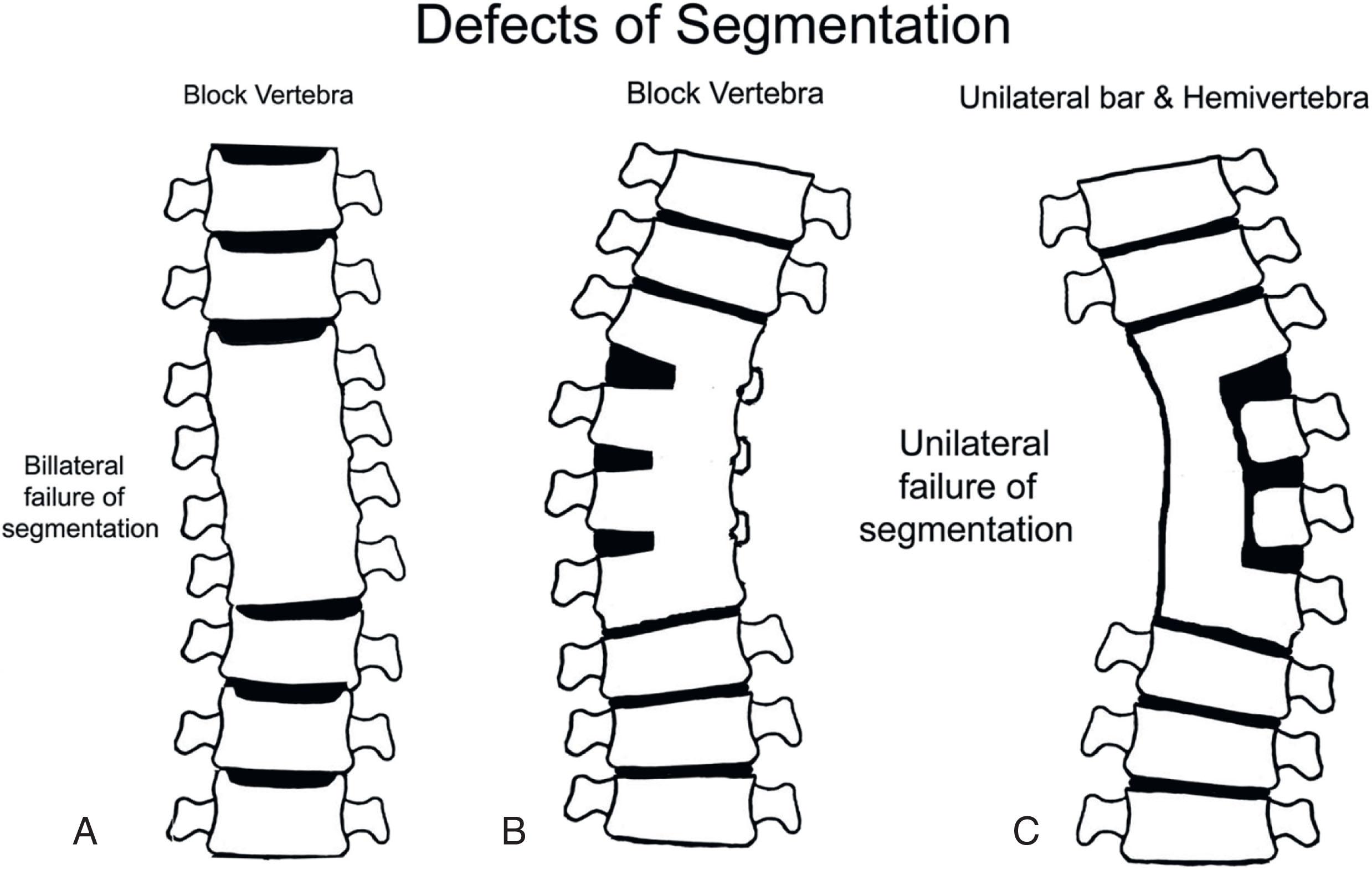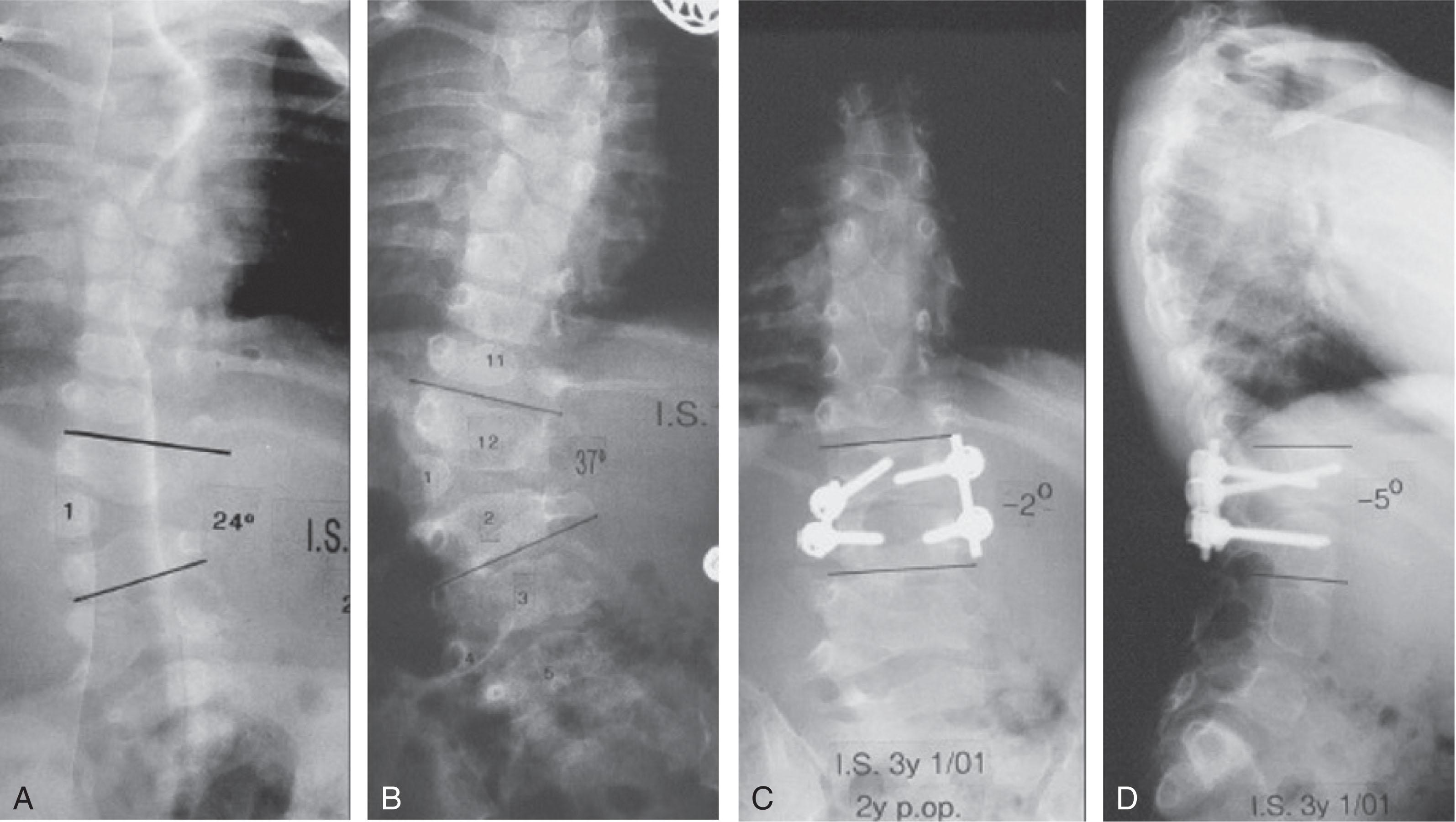Physical Address
304 North Cardinal St.
Dorchester Center, MA 02124
Treating congenital spine deformities is notoriously challenging, largely because the range of anomalies is so broad and heterogeneous that there is no accepted algorithm for treatment; each patient’s care must be planned case-by-case. Additionally, the timeline of treatment frequently ranges from infancy to skeletal maturity, often with numerous surgeries along the way. Spinal deformities include several categories of disease, such as congenital scoliosis, congenital kyphosis, and Klippel–Feil syndrome (KFS; abnormal fusion of cervical vertebrae). Congenital scoliosis is the most common of these diagnoses and will be the primary focus of this chapter. Regardless of the specific diagnosis though, treatment of congenital spine deformities is fraught with potential complications. These include preoperative complications such as problems caused by concomitant deformities in other body systems, complications of nonoperative treatment such as rapid progression of the spinal curvature or skin problems from casting, intraoperative problems such as neurologic injuries during hemivertebrectomy or vertebral column resection (VCR), and a plethora of postoperative complications including implant failure, infection, limited thoracic height, and even significant socioeconomic burdens from repeated surgeries.
By definition, congenital spine deformities are present at birth. In general, congenital spine anomalies fall into two categories: failure of formation (such as a hemivertebra) and failure of segmentation (such as osseous bars between vertebrae tethering the spine and causing growth arrest). These can also be mixed; a unilateral hemivertebra with a contralateral bar is notorious as the pattern with the most rapid progression, typically requiring surgery at a very young age ( Fig. 22.1 ).

Knowledge of the natural history of these congenital deformities is essential to determine treatment and avoid complications, and the natural history depends on the type and location of the malformation. Block and wedge vertebrae tend to have the most benign course of progression, at less than 2 degrees per year. Hemivertebrae and unilateral bar deformities progress faster, while unilateral bars with contralateral hemivertebrae are most severe, progressing up to 10 degrees per year. These curves may progress up to 50 degrees by 2 years of age.
Predictably, curve progression occurs during periods of rapid growth, such as the first 3 years of life and the adolescent growth phase. Curves are most common in the thoracic spine, but thoracolumbar curves tend to be larger, measuring greater than 40 degrees in 70% of patients who have reached maturity. The presence of rib fusions in thoracic curves has also been shown to increase risk of progression and should be monitored closely. Mixed deformities, such as a unilateral bar with contralateral hemivertebra and rib anomalies, may result in thoracic insufficiency due to severely decreased lung volumes, which can ultimately lead to respiratory failure and death.
As many as 55% of patients with congenital scoliosis may have abnormalities affecting the spinal cord or other organ systems, and a higher prevalence has been shown in patients with mixed defects. Embryonic development of the vertebrae is closely associated with the spinal cord and mesoderm. Thus, an embryonic insult may result in multiple anomalies, such as VACTERL syndrome (vertebral defects, anal atresia, cardiac anomalies, tracheoesophageal fistula, renal anomalies, and limb anomalies). Issues including renal failure, cor pulmonale, and paraplegia can occur if not screened appropriately and addressed expediently.
Defects in one system should prompt evaluation of others. The incidence of genitourinary abnormality ranges from 20% to 34% among patients with congenital scoliosis. Many anomalies have benign features such as asymptomatic unilateral absent kidney. Approximately one-third of patients require treatment for more severe anomalies such as obstructive uropathy. Every patient with congenital scoliosis warrants a renal evaluation either by ultrasound or magnetic resonance imaging. Additionally, congenital scoliosis patients have been found to have cardiac anomalies varying from ventricular septal defects to tetralogy of Fallot. Studies have shown that up to one-fourth of all congenital scoliosis patient have cardiac anomalies, half of which ultimately needed treatment. Any murmur on physical examination must be investigated by a cardiologist, and preoperative evaluation should include echocardiogram.
Examination must also include skin inspection for nevi, hemangiomas, skin dimples, and hair tufts, which are underlying indications of spinal dysraphism. Studies have reported that 20% to 38% of congenital scoliosis patients had some form of dysraphism (diastematomyelia, tethered spinal cord, fibrous dural band, syringomyelia, or intradural lipoma). Neurologic examination should also look for latent ataxia or myelopathy, symptoms that may signify other syndromes including DiGeorge, Alagille, Jarco–Levin, and Joubert, among others.
Observation is appropriate for many cases of congenital spine anomalies as long as there is not severe curvature. For example, block vertebrae can typically be observed until skeletal maturity without much risk of progression. Other deformities, such as a unilateral bar with a contralateral hemivertebra, must be followed closely due to the severity of progression, especially during periods of rapid growth. Growth-friendly surgical techniques have been employed for these curves, but the high complication rate has stimulated increased interest in delaying surgical intervention in young children with bracing or casting.
Some authors have recommended against bracing as being ineffective, especially in short, rigid curves. According to Winter, bracing is most successful in congenital scoliosis with long, flexible curves. When used, the goal of bracing is typically to delay fusion until further spinal growth has occurred. Bracing may also be used to control compensatory curves or to support head tilt in cervicothoracic curves. An important complication of bracing is chest wall deformity, so young patients with compliant chest walls must be monitored carefully. Casting is also controversial and, historically, was not used in this population. Recent studies have shown that serial casting can successfully delay definitive fusion and, thus, avoid some of the complications associated with recurrent surgical procedures. Cast complications are similar to bracing, including skin problems and recalcitrant curve progression.
Surgical treatment at young ages typically involves either short segment fusion (with or without vertebral excision such as hemivertebrectomy or VCR) or “growth-preserving” surgery.
The most commonly reported surgical strategy for congenital scoliosis is short segment fusion ( Fig. 22.2 ). The benefit of this approach is that the deformity can be fully corrected, including the focal hyperkyphosis that is typically present with hemivertebrae. Historically, combined anterior-posterior approaches were used for these surgeries, especially when hemivertebrectomy was necessary, but there has been a shift to posterior-only techniques, which tends to reduce operative time and blood loss.

Instrumentation is usually per-formed with pedicle screws, which always carry a low risk of neurologic injury. Although this risk is generally low, it is slightly higher in congenital scoliosis, as anatomy may be distorted, and patients are often very young at the time of surgery, which means smaller pedicles and weaker bone. However, even with hemivertebra resection, very low rates of neurologic injury can be achieved in experienced hands: Ruf and Harms described a series of 21 consecutive patients who underwent posterior-only hemivertebra resection with no neurologic complications.
In young patients, especially with severe deformity, there is an increased risk for pedicle overload and fracture when using pedicle screws. Pedicle fracture occurred in one of the 21 surgeries described in Ruf and Harms’ retrospective study. This complication may require lengthening the construct to include additional segments. If sufficient stability is not achieved, there is increased risk that revision surgery will be needed to add additional stability.
A retrospective cohort study by Bao et al. of 27 patients with congenital scoliosis secondary to hemivertebrae who underwent posterior thoracolumbar single hemivertebra resection reported approximately 60% correction of the coronal curve, 62% correction of the segmental kyphosis, and 70% correction of the compensatory curve distal to the hemivertebra.
Older techniques using wires were more prone to implant failure and have generally been abandoned for more modern screw and rod systems. Two out of the 21 cases in Ruf and Harms’ study underwent fixation with screws and wires. Both of these patients had failure of those implants. The remainder of the patients in the study underwent fixation with screw and rod systems, and none had implant failure. If implant failure does occur, it can be detected through postoperative imaging, frequently represents underlying pseudarthrosis, and is often accompanied by progression of the curve. This complication typically requires revision surgery.
Curves may progress after surgery if fusion is not achieved or if the congenital anomalies are not adequately addressed. For example, failure to completely remove a hemivertebra may require revision surgery with complete excision, and possibly extension of the construct. Progressive deformity can also be seen in cases with multilevel anomalies, particularly when a surgeon chooses to fuse relatively severe parts of the deformity while leaving the rest unfused to facilitate continued growth. In such cases, extension of the construct will ultimately be needed if there is too much curve progression, but ideally this can be delayed as long as possible to maximize spinal growth.
Proximal junctional kyphosis (PJK) is a parameter to consider when evaluating progression of spinal deformity. PJK is defined as a proximal junctional sagittal Cobb angle of greater than or equal to 10 degrees or a proximal junctional sagittal Cobb angle of 10 degrees (or more) larger than the preoperative measurement. This occurred in 5 of the 27 patients (18.5%) in Bao et al.’s study. These patients were treated with braces and did not undergo further surgery.
Become a Clinical Tree membership for Full access and enjoy Unlimited articles
If you are a member. Log in here